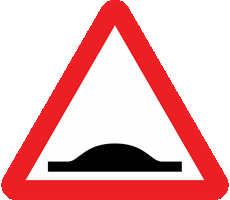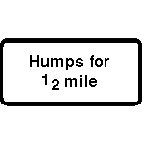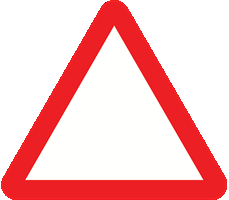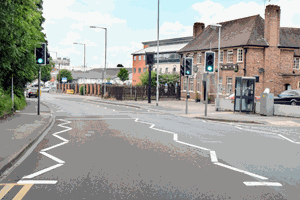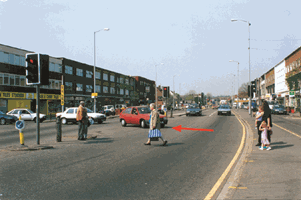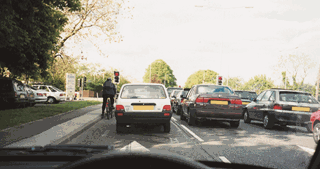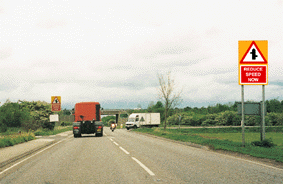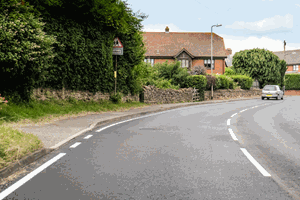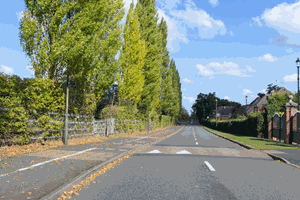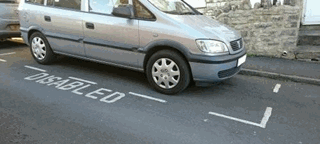You have 57 minutes to answer 50 multiple choice theory test questions. You need to answer at least 43 out of 50 questions correctly to pass. You can review your answer after each question or you can review all of your answers at the end of the test. Best of luck!
Test Quick View
Click on an answer to view the correct choice along with the explanation.
Correct Answer: C
Explanation: The safest option is to switch off your mobile phone before you set off, and use a message service. Even hands-free systems are likely to distract your attention. Don't endanger other road users. If you need to make a call, pull up in a safe place when you can, you may need to go some distance before you can find one. It's illegal to use a hand-held mobile or similar device when driving or riding, except in a genuine emergency
Explanation: The safest option is to switch off your mobile phone before you set off, and use a message service. Even hands-free systems are likely to distract your attention. Don't endanger other road users. If you need to make a call, pull up in a safe place when you can, you may need to go some distance before you can find one. It's illegal to use a hand-held mobile or similar device when driving or riding, except in a genuine emergency
Correct Answer: B
Explanation: Traffic jams today are often caused by the volume of traffic. However, inconsiderate parking can lead to the closure of an inside lane or traffic having to wait for oncoming vehicles. Driving slowly in traffic increases fuel consumption and causes a build-up of exhaust fumes.
Explanation: Traffic jams today are often caused by the volume of traffic. However, inconsiderate parking can lead to the closure of an inside lane or traffic having to wait for oncoming vehicles. Driving slowly in traffic increases fuel consumption and causes a build-up of exhaust fumes.
Correct Answer: C
Explanation: The car arrowed A is parked within the area marked by zigzag lines at the pedestrian crossing. Parking here is illegal. It also
- blocks the view for pedestrians wishing to cross the road,
- restricts the view of the crossing for approaching traffic.
Explanation: The car arrowed A is parked within the area marked by zigzag lines at the pedestrian crossing. Parking here is illegal. It also
- blocks the view for pedestrians wishing to cross the road,
- restricts the view of the crossing for approaching traffic.
Correct Answer: A
Explanation: Road humps are used to slow down the traffic. They are found in places where there are often pedestrians, such as
- in shopping areas,
- near schools,
- in residential areas. Watch out for people close to the kerb or crossing the road.
Explanation: Road humps are used to slow down the traffic. They are found in places where there are often pedestrians, such as
- in shopping areas,
- near schools,
- in residential areas. Watch out for people close to the kerb or crossing the road.
Correct Answer: B
Explanation: In a contraflow lane the traffic permitted to use it travels in the opposite direction to traffic in the other lanes on the road.
Explanation: In a contraflow lane the traffic permitted to use it travels in the opposite direction to traffic in the other lanes on the road.
Correct Answer: B, C, E, F
Explanation: Warning signs are there to make you aware of potential hazards on the road ahead. Act on the signs so you are prepared and can take whatever action is necessary.
Explanation: Warning signs are there to make you aware of potential hazards on the road ahead. Act on the signs so you are prepared and can take whatever action is necessary.
Correct Answer: A
Explanation: The approach to, and exit from, a pedestrian crossing is marked with zigzag lines. You must not park on them or overtake the leading vehicle when approaching the crossing. Parking here would block the view for pedestrians and the approaching traffic.
Explanation: The approach to, and exit from, a pedestrian crossing is marked with zigzag lines. You must not park on them or overtake the leading vehicle when approaching the crossing. Parking here would block the view for pedestrians and the approaching traffic.
Correct Answer: A
Explanation: You must obey signals given by the police. If a police officer in a patrol vehicle wants you to pull over they will indicate this without causing danger to you or other traffic.
Explanation: You must obey signals given by the police. If a police officer in a patrol vehicle wants you to pull over they will indicate this without causing danger to you or other traffic.
B
C
D
Correct Answer: D
Explanation: Passing the moped and turning into the junction could mean that you cut across the front of the rider. This might force them to slow down, stop or even lose control. Slow down and stay behind the moped until it has passed the junction and you can then turn safely.
Explanation: Passing the moped and turning into the junction could mean that you cut across the front of the rider. This might force them to slow down, stop or even lose control. Slow down and stay behind the moped until it has passed the junction and you can then turn safely.
Correct Answer: A
Explanation: To prevent your lights from dazzling the driver of the car in front, wait until you've overtaken before switching to full beam.
Explanation: To prevent your lights from dazzling the driver of the car in front, wait until you've overtaken before switching to full beam.
Correct Answer: C
Explanation: Water on the brakes will act as a lubricant, causing them to work less efficiently. Using the brakes lightly as you go along will dry them out.
Explanation: Water on the brakes will act as a lubricant, causing them to work less efficiently. Using the brakes lightly as you go along will dry them out.
Correct Answer: C
Explanation: Some people might take longer to cross the road. They may be older or have a disability. Be patient and don't hurry them by showing your impatience. They might have poor eyesight or not be able to hear traffic approaching. If pedestrians are standing at the side of the road, don't signal or wave them to cross. Other road users may not have seen your signal and this could lead the pedestrians into a hazardous situation.
Explanation: Some people might take longer to cross the road. They may be older or have a disability. Be patient and don't hurry them by showing your impatience. They might have poor eyesight or not be able to hear traffic approaching. If pedestrians are standing at the side of the road, don't signal or wave them to cross. Other road users may not have seen your signal and this could lead the pedestrians into a hazardous situation.
Correct Answer: A
Explanation: If you want to turn left and there's a cyclist in front of you, hold back. Wait until the cyclist has passed the junction and then turn left behind them.
Explanation: If you want to turn left and there's a cyclist in front of you, hold back. Wait until the cyclist has passed the junction and then turn left behind them.
Correct Answer: C
Explanation: The blue and red circular sign on its own means that waiting restrictions are in force. This sign shows that you are leaving the controlled zone and waiting restrictions no longer apply.
Explanation: The blue and red circular sign on its own means that waiting restrictions are in force. This sign shows that you are leaving the controlled zone and waiting restrictions no longer apply.
15. Traffic officers are used on motorways and some 'A' class roads. In which part of the United Kingdom do they operate?
Mark one answer
B
C
D
Correct Answer: A
Explanation: Traffic officers have powers to stop vehicles on safety grounds, for example if you have an insecure load, in England and Wales. It's an offence not to comply with their directions.
Explanation: Traffic officers have powers to stop vehicles on safety grounds, for example if you have an insecure load, in England and Wales. It's an offence not to comply with their directions.
Correct Answer: A
Explanation: There are some occasions when you may have to stop on the carriageway of a motorway. These include when being signalled by the police or a traffic officer, when a red cross shows above every lane and in traffic jams.
Explanation: There are some occasions when you may have to stop on the carriageway of a motorway. These include when being signalled by the police or a traffic officer, when a red cross shows above every lane and in traffic jams.
Correct Answer: C
Explanation: You should not normally stop on a motorway but there may be occasions when you need to do so. If you are unfortunate enough to break down make every effort to pull up on the hard shoulder.
Explanation: You should not normally stop on a motorway but there may be occasions when you need to do so. If you are unfortunate enough to break down make every effort to pull up on the hard shoulder.
18. You are travelling at 50 mph on a good, dry road. What is your typical overall stopping distance?
Mark one answer
B
C
D
Correct Answer: B
Explanation: Even in good conditions it will usually take you further than you think to stop. Don't just learn the figures, make sure you understand how far the distance is.
Explanation: Even in good conditions it will usually take you further than you think to stop. Don't just learn the figures, make sure you understand how far the distance is.
19. You are on a motorway. A large box falls onto the road from a lorry. The lorry does not stop. You should
Mark one answer
B
C
D
Correct Answer: B
Explanation: Lorry drivers can be unaware of objects falling from their vehicles. If you see something fall onto a motorway look to see if the driver pulls over. If they don't stop, do not attempt to retrieve it yourself. Pull on to the hard shoulder near an emergency telephone and report the hazard.
Explanation: Lorry drivers can be unaware of objects falling from their vehicles. If you see something fall onto a motorway look to see if the driver pulls over. If they don't stop, do not attempt to retrieve it yourself. Pull on to the hard shoulder near an emergency telephone and report the hazard.
Correct Answer: A, B, D
Explanation: Slow down and be ready to stop if you see animals in the road ahead. Animals are easily frightened by noise and vehicles passing too close to them. Stop if signalled to do so by the person in charge.
Explanation: Slow down and be ready to stop if you see animals in the road ahead. Animals are easily frightened by noise and vehicles passing too close to them. Stop if signalled to do so by the person in charge.
Correct Answer: D
Explanation: When approaching a tunnel switch on your dipped headlights. Be aware that your eyes might need to adjust to the sudden darkness. You may need to reduce your speed.
Explanation: When approaching a tunnel switch on your dipped headlights. Be aware that your eyes might need to adjust to the sudden darkness. You may need to reduce your speed.
22. A casualty has an injured arm. They can move it freely but it is bleeding. Why should you get them to keep it in a raised position?
Mark one answer
B
C
D
Correct Answer: C
Explanation: If a casualty is bleeding heavily, raise the limb to a higher position. This will help to reduce the blood flow. Before raising the limb you should make sure that it is not broken.
Explanation: If a casualty is bleeding heavily, raise the limb to a higher position. This will help to reduce the blood flow. Before raising the limb you should make sure that it is not broken.
Correct Answer: A, D, E
Explanation: In a contraflow system you will be travelling close to oncoming traffic and sometimes in narrow lanes. You should obey the temporary speed limit signs, get into the correct lane at the proper time and keep a safe separation distance from the vehicle ahead. When traffic is at a very low speed, merging in turn is recommended if it's safe and appropriate.
Explanation: In a contraflow system you will be travelling close to oncoming traffic and sometimes in narrow lanes. You should obey the temporary speed limit signs, get into the correct lane at the proper time and keep a safe separation distance from the vehicle ahead. When traffic is at a very low speed, merging in turn is recommended if it's safe and appropriate.
24. You are about to go down a steep hill. To control the speed of your vehicle you should
Mark one answer
B
C
D
Correct Answer: D
Explanation: When going down a steep hill your vehicle will speed up. This will make it more difficult for you to stop. Select a lower gear to give you more engine braking and control. Use this in combination with careful use of the brakes.
Explanation: When going down a steep hill your vehicle will speed up. This will make it more difficult for you to stop. Select a lower gear to give you more engine braking and control. Use this in combination with careful use of the brakes.
Correct Answer: D
Explanation: If you are waiting at traffic lights, check all around you before you move away, as cyclists often filter through waiting traffic. Allow the cyclist to move off safely.
Explanation: If you are waiting at traffic lights, check all around you before you move away, as cyclists often filter through waiting traffic. Allow the cyclist to move off safely.
Correct Answer: B
Explanation: There could be stationary traffic ahead, waiting to turn right. Other traffic could be emerging and it may take time for them to gather speed.
Explanation: There could be stationary traffic ahead, waiting to turn right. Other traffic could be emerging and it may take time for them to gather speed.
27. You are about to return home from holiday when you become ill. A doctor prescribes drugs which are likely to affect your driving. You should
Mark one answer
B
C
D
Correct Answer: D
Explanation: Find another way to get home even if this proves to be very inconvenient. You must not put other road users, your passengers or yourself at risk.
Explanation: Find another way to get home even if this proves to be very inconvenient. You must not put other road users, your passengers or yourself at risk.
Correct Answer: D
Explanation: A continuous white line is used on many roads to indicate the edge of the carriageway. This can be useful when visibility is restricted. The line is discontinued at junctions, lay-bys and entrances and exits from private drives.
Explanation: A continuous white line is used on many roads to indicate the edge of the carriageway. This can be useful when visibility is restricted. The line is discontinued at junctions, lay-bys and entrances and exits from private drives.
Correct Answer: C
Explanation: Don't attempt to overtake here, as there might be unseen hazards over the brow of the hill. Keep to the left.
Explanation: Don't attempt to overtake here, as there might be unseen hazards over the brow of the hill. Keep to the left.
Correct Answer: C
Explanation: Pull up on the hard shoulder and make your way to the nearest emergency telephone to call for assistance. Do not attempt to repair your vehicle while it is on the hard shoulder because of the risk posed by traffic passing at high speeds.
Explanation: Pull up on the hard shoulder and make your way to the nearest emergency telephone to call for assistance. Do not attempt to repair your vehicle while it is on the hard shoulder because of the risk posed by traffic passing at high speeds.
Correct Answer: B, D, E
Explanation: Rapid acceleration and heavy braking lead to greater fuel consumption. They also increase wear and tear on your vehicle.Having your vehicle regularly serviced means your engine will maintain its efficiency, produce cleaner emissions and lengthen its life.
Explanation: Rapid acceleration and heavy braking lead to greater fuel consumption. They also increase wear and tear on your vehicle.Having your vehicle regularly serviced means your engine will maintain its efficiency, produce cleaner emissions and lengthen its life.
Correct Answer: A, B, D
Explanation: Looking at road maps while driving is very dangerous. If you aren't sure of your route stop in a safe place and check the map. You must not allow anything to take your attention away from the road.If you need to use a mobile phone, stop in a safe place before doing so.
Explanation: Looking at road maps while driving is very dangerous. If you aren't sure of your route stop in a safe place and check the map. You must not allow anything to take your attention away from the road.If you need to use a mobile phone, stop in a safe place before doing so.
Correct Answer: C
Explanation: It is your responsibility to make sure you are properly insured for the vehicle you are driving.
Explanation: It is your responsibility to make sure you are properly insured for the vehicle you are driving.
Correct Answer: B
Explanation: You should brake and slow down before selecting a lower gear. The gear can then be used to keep the speed low and help you control the vehicle. This is particularly helpful on long downhill stretches, where brake fade can occur if the brakes overheat.
Explanation: You should brake and slow down before selecting a lower gear. The gear can then be used to keep the speed low and help you control the vehicle. This is particularly helpful on long downhill stretches, where brake fade can occur if the brakes overheat.
Correct Answer: B
Explanation: An immobiliser makes it more difficult for your vehicle to be driven off by a thief. It is a particular deterrent to opportunist thieves.
Explanation: An immobiliser makes it more difficult for your vehicle to be driven off by a thief. It is a particular deterrent to opportunist thieves.
36. You are approaching a zebra crossing. Pedestrians are waiting to cross. You should
Mark one answer
B
C
D
Correct Answer: B
Explanation: Look out on the approach especially for children and older pedestrians. They may walk across without looking. Zebra crossings have flashing amber beacons on both sides of the road, black and white stripes on the crossing and white zigzag markings on both sides of the crossing. Where you can see pedestrians waiting to cross, slow down and prepare to stop.
Explanation: Look out on the approach especially for children and older pedestrians. They may walk across without looking. Zebra crossings have flashing amber beacons on both sides of the road, black and white stripes on the crossing and white zigzag markings on both sides of the crossing. Where you can see pedestrians waiting to cross, slow down and prepare to stop.
Correct Answer: D
Explanation: The humps are there for a reason - to reduce the speed of the traffic. Don't accelerate harshly between them as this means you will only have to brake harshly to negotiate the next hump. Harsh braking and accelerating uses more fuel.
Explanation: The humps are there for a reason - to reduce the speed of the traffic. Don't accelerate harshly between them as this means you will only have to brake harshly to negotiate the next hump. Harsh braking and accelerating uses more fuel.
B
C
D
Correct Answer: B
Explanation: Windscreen pillars can obstruct your view, particularly at bends and junctions. Look out for other road users, particularly cyclists and pedestrians, as they can be hard to see.
Explanation: Windscreen pillars can obstruct your view, particularly at bends and junctions. Look out for other road users, particularly cyclists and pedestrians, as they can be hard to see.
Correct Answer: A
Explanation: Some bus lanes only operate during peak hours and other vehicles may use them outside these hours. Make sure you check the sign for the hours of operation before driving in a bus lane.
Explanation: Some bus lanes only operate during peak hours and other vehicles may use them outside these hours. Make sure you check the sign for the hours of operation before driving in a bus lane.
B
C
D
Correct Answer: A
Explanation: It's an offence to park there. You will be causing an obstruction by obscuring the view of both pedestrians and drivers.
Explanation: It's an offence to park there. You will be causing an obstruction by obscuring the view of both pedestrians and drivers.
B
C
D
Correct Answer: C
Explanation: If your vehicle breaks down in a tunnel it could present a danger to other traffic. First switch on your hazard warning lights and then call for help from an emergency telephone point. Don't rely on being found by the police or being seen by a CCTV camera. The longer the vehicle stays in an exposed position, the more danger it poses to other drivers.
Explanation: If your vehicle breaks down in a tunnel it could present a danger to other traffic. First switch on your hazard warning lights and then call for help from an emergency telephone point. Don't rely on being found by the police or being seen by a CCTV camera. The longer the vehicle stays in an exposed position, the more danger it poses to other drivers.
42. You are driving down a long steep hill. You suddenly notice your brakes are not working as well as normal. What is the usual cause of this?
Mark one answer
B
C
D
Correct Answer: D
Explanation: This is more likely to happen on vehicles fitted with drum brakes but can apply to disc brakes as well. Using a lower gear will assist the braking and help you to keep control of your vehicle.
Explanation: This is more likely to happen on vehicles fitted with drum brakes but can apply to disc brakes as well. Using a lower gear will assist the braking and help you to keep control of your vehicle.
Correct Answer: A
Explanation: A flashing amber light is shown at pelican crossings, but puffin crossings are different. They are controlled electronically and automatically detect when pedestrians are on the crossing. The phase is shortened or lengthened according to the position of the pedestrians.
Explanation: A flashing amber light is shown at pelican crossings, but puffin crossings are different. They are controlled electronically and automatically detect when pedestrians are on the crossing. The phase is shortened or lengthened according to the position of the pedestrians.
B
C
D
Correct Answer: C
Explanation: If you follow another vehicle with your headlights on full beam they could dazzle the driver. Leave a safe distance and ensure that the light from your dipped beam falls short of the vehicle in front.
Explanation: If you follow another vehicle with your headlights on full beam they could dazzle the driver. Leave a safe distance and ensure that the light from your dipped beam falls short of the vehicle in front.
45. Holding the clutch pedal down or rolling in neutral for too long while driving will
Mark one answer
B
C
D
Correct Answer: C
Explanation: Holding the clutch down or staying in neutral for too long will cause your vehicle to freewheel. This is known as 'coasting' and it is dangerous as it reduces your control of the vehicle.
Explanation: Holding the clutch down or staying in neutral for too long will cause your vehicle to freewheel. This is known as 'coasting' and it is dangerous as it reduces your control of the vehicle.
Correct Answer: D
Explanation: The vehicle you drive MUST be roadworthy and in good condition. If it's over three years old it MUST pass an MOT test to remain in use on the road. Vehicles made before 1960 are exempt from the MOT test, but must be in a roadworthy condition before being driven on the road.
Explanation: The vehicle you drive MUST be roadworthy and in good condition. If it's over three years old it MUST pass an MOT test to remain in use on the road. Vehicles made before 1960 are exempt from the MOT test, but must be in a roadworthy condition before being driven on the road.
B
C
D
Correct Answer: D
Explanation: When your view is restricted into the new road you must still be completely sure it is safe to emerge. Try to look for traffic through the windows of the parked cars or the reflections in shop windows. Keep looking in all directions as you slowly edge forwards until you can see it is safe.
Explanation: When your view is restricted into the new road you must still be completely sure it is safe to emerge. Try to look for traffic through the windows of the parked cars or the reflections in shop windows. Keep looking in all directions as you slowly edge forwards until you can see it is safe.
48. You are driving on a motorway and want to use your mobile phone. What should you do?
Mark one answer
B
C
D
Correct Answer: A
Explanation: Except in a genuine emergency you MUST NOT use your mobile phone when driving. If you need to use it leave the motorway and find a safe place to stop. Even a hands-free phone can distract your attention. Use your voicemail to receive calls. Driving requires all of your attention, all of the time.
Explanation: Except in a genuine emergency you MUST NOT use your mobile phone when driving. If you need to use it leave the motorway and find a safe place to stop. Even a hands-free phone can distract your attention. Use your voicemail to receive calls. Driving requires all of your attention, all of the time.
49. Young, inexperienced and newly qualified drivers can often be involved in crashes. This is due to
Mark one answer
B
C
D
Correct Answer: C
Explanation: Newly qualified, and particularly young drivers, are more vulnerable in the first year after passing the test. Inexperience plays a part in this but it's essential to have the correct attitude. Be responsible and always show courtesy and consideration to other road users.
Explanation: Newly qualified, and particularly young drivers, are more vulnerable in the first year after passing the test. Inexperience plays a part in this but it's essential to have the correct attitude. Be responsible and always show courtesy and consideration to other road users.
Correct Answer: A
Explanation: Don't park in a space reserved for disabled people unless you or your passenger are a disabled badge holder. The badge must be displayed in your vehicle in the bottom left-hand corner of the windscreen.
Explanation: Don't park in a space reserved for disabled people unless you or your passenger are a disabled badge holder. The badge must be displayed in your vehicle in the bottom left-hand corner of the windscreen.




